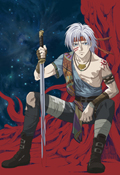 During my research on Murakami Ryu I realized that Murakami’s been observing both mass culture & subculture phenomena from an almost outsider’s point of view while at the same time he himself is part of this mass media monster, this huge machinery (with both positive and negative qualities) in which everyone seems to be influenced by everyone in their output and instantly influences others the second they publish their ‘product’/output. As controversial as his thoughts and works might be, Murakami has already influenced a flock of younger writers, some of which have paid homage to his works through tiny details in their own works. As an example for that, here are a few connections between Murakami and anime:
During my research on Murakami Ryu I realized that Murakami’s been observing both mass culture & subculture phenomena from an almost outsider’s point of view while at the same time he himself is part of this mass media monster, this huge machinery (with both positive and negative qualities) in which everyone seems to be influenced by everyone in their output and instantly influences others the second they publish their ‘product’/output. As controversial as his thoughts and works might be, Murakami has already influenced a flock of younger writers, some of which have paid homage to his works through tiny details in their own works. As an example for that, here are a few connections between Murakami and anime:
1, The naming of a handful of (minor) characters from Eva was apparently inspired by character names from Murakami’s novel Ai to Gensou no Fashizumu (1987) as Anno Hideaki, the director of the anime, later wrote in an essay.
For example, there’s Suzuhara Touji (鈴原トウジ) whose name was “borrowed” from the protagonist of Fashizumu, Suzuhara Touji (鈴原冬二). His friend Aida Kensuke (相田ケンスケ) also has a doppelgänger – by name, at least – in the novel (相田剣介). The surname of their friend Hikari, Horaki (洞木), is used in the novel for a male character called Horaki Kouichi (洞木紘一).
One person appearing in the novel called Yamagishi Ryouji (山岸良治) might have been a source of inspiration in the naming of Kaji Ryouji (åŠ æŒãƒªãƒ§ã‚¦ã‚¸) and Yamagishi Mayumi ((山岸マユミ), the female main character from the Sega Saturn game Evangelion 2nd Impression, though Anno said the ‘Ryouji’ came from a character in a Narita Minako manga, so who knows… There’s also a bunch of very minor characters whose names can also be found in Murakami’s novel, like Tokita Shirou (時田シãƒã‚¦; inspired by Tokita Shirou – 時田å²éƒŽ – in the novel).
The Murakami/Anno connection continues. In 1998 Anno Hideaki made his non-anime directorial debut when he had the chance to adapt Love&Pop, Murakami Ryu’s short novel about enjo kousai which was published in 1996, for the big screen.
2,  And then there’s Eureka seveN (2005), the current generation’s Evangelion, which I admittedly quite enjoyed, though not nearly as much as Eva. It was written by the highly celebrated screenwriter Satou Dai, who also wrote (episodes of) other brilliant anime series such as Cowboy Bebop, Wolf’s Rain, Ergo Proxy and Terra e…, to name just a few. He apparently made a cross-reference to Anemone, the female protagonist in Murakami’s Coin Locker Babies (1980) by naming the pink-haired Anemone, the oh-so-tormented pilot of the Nirvash LFO TheEND, after her. In the book, Anemone has an alligator called Gulliver and in the anime, Anemone’s pet is this weird mixture of a duck, a sheep and something indefinable that is called Gulliver, too.
And then there’s Eureka seveN (2005), the current generation’s Evangelion, which I admittedly quite enjoyed, though not nearly as much as Eva. It was written by the highly celebrated screenwriter Satou Dai, who also wrote (episodes of) other brilliant anime series such as Cowboy Bebop, Wolf’s Rain, Ergo Proxy and Terra e…, to name just a few. He apparently made a cross-reference to Anemone, the female protagonist in Murakami’s Coin Locker Babies (1980) by naming the pink-haired Anemone, the oh-so-tormented pilot of the Nirvash LFO TheEND, after her. In the book, Anemone has an alligator called Gulliver and in the anime, Anemone’s pet is this weird mixture of a duck, a sheep and something indefinable that is called Gulliver, too.
Oh, the geekiness!

 I had a tiny bit of time to watch anime which means I finally managed to finish
I had a tiny bit of time to watch anime which means I finally managed to finish  vs.
vs. 